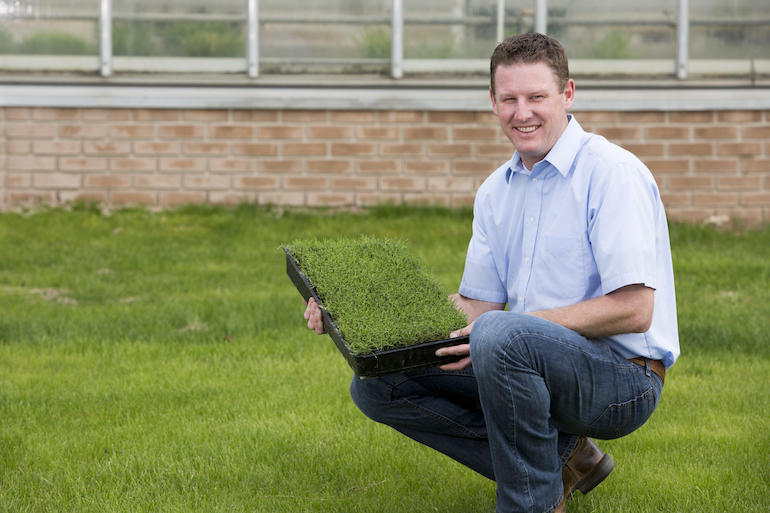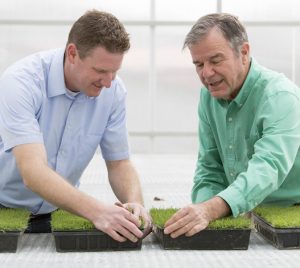
The Summer Olympics may be in Japan right now, but Team USA was on home turf when they took the field for last week’s Opening Ceremony.
The Japan National Olympic Stadium’s field was initially sodded with TifSport bermudagrass, developed in south Georgia. One of many grass varieties created and tested at the University of Georgia’s Tifton Campus, TifSport is a dense, medium- to fine-textured grass bred to withstand the high traffic sports fields while tolerating herbicides.
Several days later, the field was resodded with TifGrand bermudagrass, a dense, very dark green grass. “It has a really thick root system that’s right at the top of the field for sports where your cleats are interacting within that top inch of soil or so,” said Brian Schwartz, a professor of crop and soil sciences in the College of Agricultural and Environmental Sciences.
From Georgia To Japan
But how did Georgia-grown grass end up in Tokyo at the Olympic Stadium?
“People won’t just change out the Super Bowl stadium field just because you tell them it’s a really good grass,” commented Schwartz. “As a grass performs well over many years, then they start switching things out. And I think that’s how TifGrand really made its way into the Olympics.”
TifGrand is also incredibly shade tolerant, which is key for a stadium, like Japan’s National Stadium, that has high walls of seating and roofing that could hinder grass growth. “It’s easy to claim ‘shade tolerance’ verbally, but it’s not easy to verify such traits scientifically,” said Fumi Miyachi, of Chubu Company in Japan, the company responsible for researching and finding the perfect grasses for the Olympic stadium. “TifGrand was the only scientifically-proven variety in the industry. We quickly signed an experimental evaluation agreement and tested TifGrand locally. The result was more than our expectations.”
A Long History

UGA’s Tifton campus is known worldwide for its turfgrass research, with scientists like Glenn Burton leading innovation in turf since the 1950s. Another former professor of Crop and Soil Sciences and Schwarts’s predecessor, Wayne Hanna, spent almost three decades developing cultivars with improved shade tolerance while maintaining a pretty, dense and dark green surface. Over the years, UGA and USDA researchers created Tifway and Tifdwarf, two bermudagrass hybrids that for years covered more golf courses, athletic fields, and lawns that any other turf varieties in the world. For decades, Tifway remained the gold standard.
“Tifton has very sandy soil, it rains a lot and then it doesn’t rain at all, there are bugs that attack plants (and people)—it’s a very tough place to survive for a lot of plants,” commented Schwartz. “But that makes it a very successful plant breeding location for almost all crops.”
UGA researchers spend anywhere from five to 10 years —and sometimes more— “trying to kill all the turfgrasses we can. Let’s not fertilize them enough. Let’s beat them up with our traffic machine,” joked Schwartz. At the end of the process, the five or 10 grasses left standing are then tested throughout the state, then the Southeast, and beyond. “It’s a long process, and I would like it to be quicker. But it is the long process that helps you have a stable product,” Schwartz said.
The result of decades of testing, TifTuf is a beautiful bermudagrass with superior drought and wear tolerance. Meanwhile TifSport, which can stand up to pests and cold, remains one of the top sellers of all time. Released in 2008, TifGrand has taken off and is particularly appealing to sports venues, even Olympic ones.
Today, scientists like Schwartz work with UGA Cooperative Extension specialists to build and grow relationships with people and companies around the world. “The turf program’s success is a huge team effort all the way from my 16-year-old brand new student worker to people who’ve been at the Tifton campus for longer than I have,” Schwartz said. “We’re here to serve the greater need of our society. It’s a neat mission of the land-grant system here that we can take our time and focus on making a difference in this industry.”
An original version of this article appeared in UGA Today.











![[VIDEO] Dickies®: Discover Workwear That’s Anything But Uniform](https://turfmagazine.com/wp-content/uploads/2023/06/1647663814-4b1a2a7742790a9b1e97a3b963477850192e1d6a9dfba9b07214a77bae25d6e3-d-218x150.jpg)





























![[VIDEO] Dickies®: Discover Workwear That’s Anything But Uniform](https://turfmagazine.com/wp-content/uploads/2023/06/1647663814-4b1a2a7742790a9b1e97a3b963477850192e1d6a9dfba9b07214a77bae25d6e3-d-324x160.jpg)